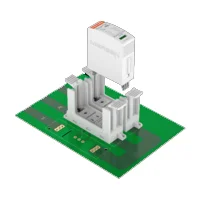
Surge Protection for Solar Photovoltaic Systems HelioProtection® Solutions by Mersen
Solar is the fastest-growing power-generation source.
Solar is the fastest-growing power-generation source. More solar photovoltaic (PV) capacities were installed globally than any other power-generation technology in 2017. PV added almost twice as much capacity as wind.
The SolarPower Europe association has predicted 45 percent growth for 2018 and 58 percent for 2019 in Europe, with Germany, France and Turkey expected to be the top three solar markets in the continent in the years up to 2022.
Compared to other voltage ratings, 1500VDC PV technology has consolidated its worldwide dominance. All components of such installations need specific 1500VDC electrical protection to safeguard the generation plant’s return on investment. Mersen HelioProtection® is the name of the platform of overcurrent and surge-protection solutions that are fully designed for solar PV and are 1500VDC-ready. Surge-Trap® is the specific name of the group of surge-protection devices (SPDs) on offer.
DC & AC Side SPDs for combiner boxes and inverters
Surge-protection devices are installed on the DC and AC sides of central and string inverters, in combiner boxes and to protect signal lines (measurements and communications). Depending on the atmospheric exposure of the PV plant to lightning, engineering, procurement and construction (EPC) contractors and designers may prescribe either standard type 2 IEC SPDs (indirect impact 8/20 μs) or more robust type 1+2 SPDs (tested to withstand direct lightning impacts in 10/350 μs waveform).
DC side protection at combiner boxes and inverters typically has a Y-connection DIN-rail configuration in order to provide common and differential mode protection. Regardless of the SPD type and voltage rating, no additional back-up fuse will be needed thanks to Mersen’s optimized dynamic thermal disconnection system for DC PV currents, with at least 10 kA short-circuit withstand rating.
On the AC side, overvoltage protection of the inverter is likewise required. Whether at the inverter itself or at the AC combiner box, exposure to voltage surges is generally addressed by using standard DIN-rail type 2 SPDs in TN S, IT or even TT configurations. Due to the 1500VDC trend and how this also entails an increase in the output voltage ratings on the AC side (up to 800 V L-L), Mersen has developed special 850 V AC UC SPDs. These are reinforced to handle recurring (nontransient) voltage peaks of up to 2.2 kV that may occur in certain installations where the DC negative pole is earthed. This causes an AC voltage offset via the grounding (PE) of the SPDs themselves. Premature wear is avoided.
Moreover, depending on the PV installation, type 1+2 AC may be favored in some cases by EPC contractors and designers, in order to achieve a longer lifetime for SPDs and even protection where conditions are harsher in terms of the expected direct lightning impact. This will typically be the case in areas with a very high isoceraunic level, often associated with high altitudes. Therefore, Mersen SPDs have been designed to meet electrical requirements at high altitudes (DC and AC).
Multipole SPDs for high-power string inverters
For both the DC and AC side of PV installations, most Mersen SPD products comply with both UL and IEC standards in the same device, even for special designs such as the DC multipole SPDs for inverters with multiple maximum power-point trackers (MPPTs).
Such special designs are tailored especially to the needs of OEM inverter manufacturers. The segment of high-power string inverters is increasingly used in commercial or industrial and even utility-scale applications in competition with central inverters. In string inverters, strings are managed by means of several MPPTs, which enables performance to be optimized in relation to cost. Multiple MPPTs allow for the inverter to have several independent lines of PV panels operating at their maximum power point. Hence, a substantial increase in performance is achieved when there are unfavorable conditions such as shadowing, adverse sun orientation and dirt. These MPPTs are the sensitive part on the DC side of the inverter and need to be protected against voltage surges. In string inverters, more SPDs are required at the same time, which means that space and cost become an issue. Standard Y-connection DIN-rail PV SPDs cannot be an efficient configuration in such cases. Special multipole SPDs are required inside string inverters. As with their configuration, the number of their poles ultimately depends on the number of MPPTs and on the internal design of the string inverter.
The demand for cost and space efficiency in the power electronics industry has ultimately led inverter manufacturers to push for a change in format of multipole SPDs from DIN-rail to PCB-assembly format. The best solution is to have the surge base in the form of a special single-pole socket that can be wave-soldered in any network configuration on the PCB, along with other power electronics components. This avoids wiring costs but must usually be planned for at an early stage of the inverter design. Mersen offers a new PCB surge socket that can host any of the company’s standard DC and AC plug-in surge cartridges, both type 2 and type 1+2, of any voltage rating.
Why Mersen Helioprotection® SPDs?
The Mersen HelioProtection Surge-Trap program offers a flexible platform of solutions for power-line and signal-line protection for PV equipment. Surge-Trap is the most comprehensive and flexible solution on the market for power-line surge protection for PV equipment. All one-module-wide plug-in surge cartridges can be used indistinctly across DIN-rail bases and PCB surge-socket bases. This is true for both type 2 and type 1+2 SPDs. The program is also 1500VDC-ready and offers solutions for specific PV issues on the DC side for multiple MPPTs and on the AC side with reinforced voltage ratings. Devices are both IEC- and UL-compliant. No back-up fuse is required on the DC side.